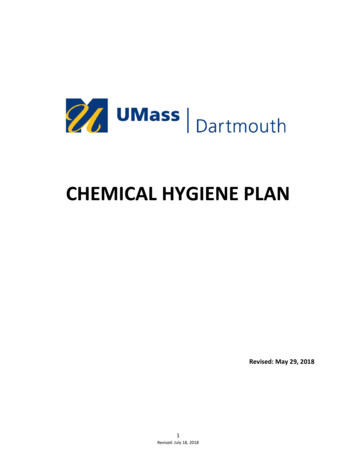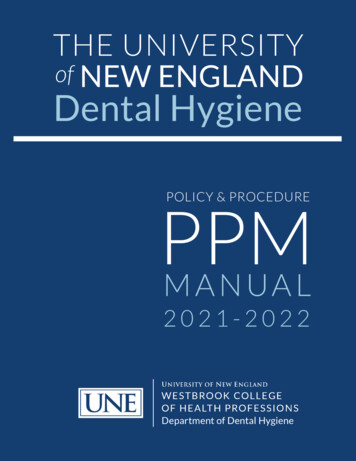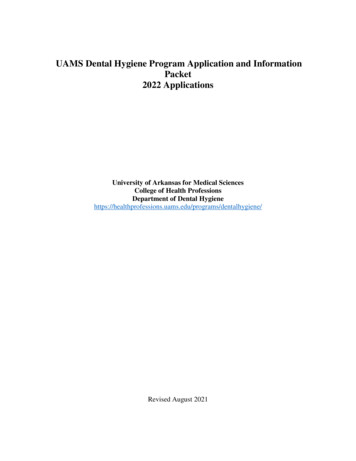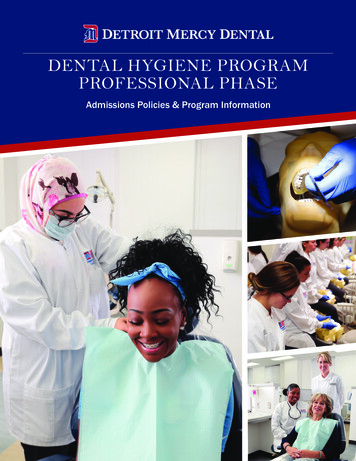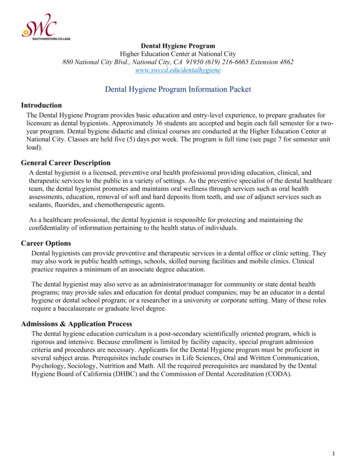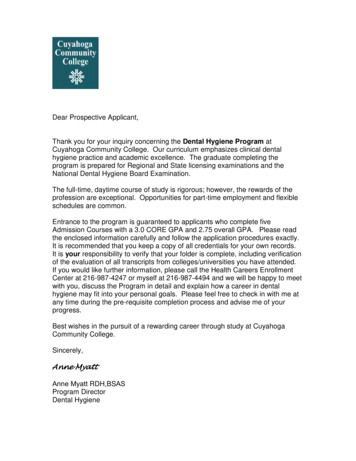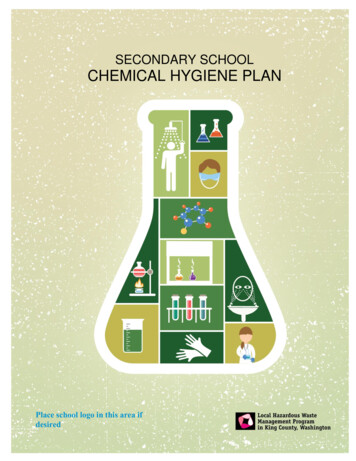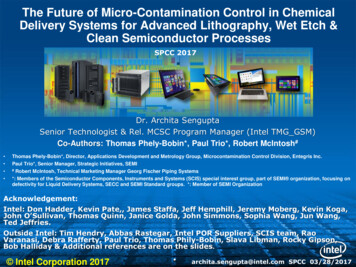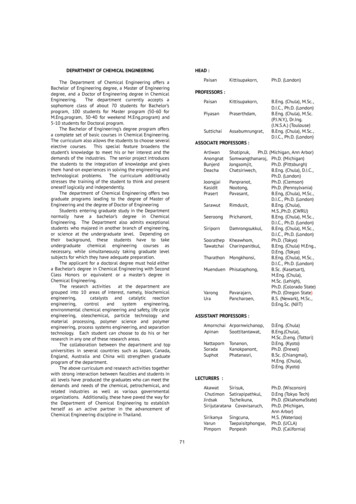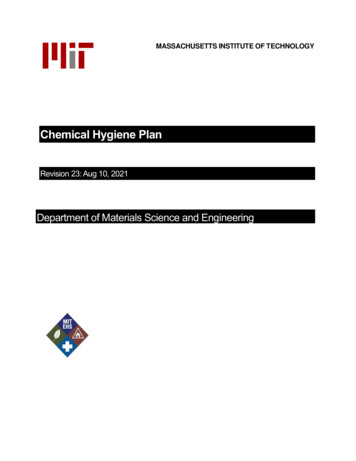
Transcription
MASSACHUSETTS INSTITUTE OF TECHNOLOGYChemical Hygiene PlanRevision 23: Aug 10, 2021Department of Materials Science and Engineering
Table of ContentsPART I. Getting Started . 31.INTRODUCTION . 31.1.1.2.2.Purpose, Policy, and Scope . 3Plan Organization. 4ROLES AND RESPONSIBILITIES . 42.1.2.2.2.3.2.4.2.5.2.6.2.7.2.8.3.The DEPARTMENT, LAB, or CENTER CHAIR . 4The CHEMICAL HYGIENE OFFICER. 4The EHS COORDINATOR . 5The PRINCIPAL INVESTIGATOR or LABORATORY SUPERVISOR . 5The EHS REPRESENTATIVE . 7The ENVIRONMENT, HEALTH and SAFETY (EHS) OFFICE . 7EMPLOYEES, STAFF, STUDENTS. 8VISITORS, TOURS and PETS. 8TRAINING . 93.1.3.2.4.Training Requirements . 9Training Records . 9INFORMATION REQUIREMENTS . 104.14.24.3.Basic Requirements . 10Chemical Safety Information Sources . 10Guidance and resources for COVID-19 response. 12PART II. General Chemical Hygiene Practices . 131.INTRODUCTION . 132.IDENTIFICATION AND CLASSIFICATION OF HAZARDOUS CHEMICALS . 142.1.2.2.2.3.2.4.2.5.2.6.2.7.2.83.Possible Animal Carcinogens . 14Corrosive Substances . 15Irritants . 15Sensitizers. 15Flammable, Highly Reactive and Explosive Substances . 15Hazardous Substances with Toxic Effects on Specific Organs . 15Particularly Hazardous Substances/Select Carcinogens . 16Green Chemistry . 19STANDARD OPERATING PROCEDURES FOR WORK WITH HAZARDOUS CHEMICALS . 203.1.3.2.3.3.3.4.3.5.3.6.3.73.83.93.10Preliminary Steps and Procedures . 20Essential Laboratory Work Practices . 24Additional Procedures for Work with Particularly Hazardous Substances . 29Additional Requirements for Work with Select Toxins . 31Special Precautions for Work with Hydrofluoric Acid . 31Special Precautions for Work with Formaldehyde . 32Special Precautions for Work with Nanomaterials . 32Special Precautions for Work with Cyanide Salts and Compounds . 33Special Precautions for Work with Pyrophoric and Water-Reactive Materials . 33Special Precautions for Work with Cytotoxic Drugs. 344.PERSONAL PROTECTIVE EQUIPMENT . 345.OTHER SAFETY AND STORAGE EQUIPMENT . 35PAGE 1
5.1.5.2.5.3.5.4Laboratory Fume Hoods/Ventilation . 35Fire Extinguishers, Safety Showers, and Eyewash Stations . 36Safe Use of Warm and Cold Environmental Rooms . 37Electrical Safety and Lockout/tagout Considerations . 376.CHEMICAL CONTAINER LABELING GUIDELINES . 387.COMPRESSED GAS CYLINDERS . 388.CHEMICAL WASTE MANAGEMENT. 398.1.8.2.8.3.8.4Waste Management Responsibility . 39Training. 39Procedures for Hazardous Waste Generators . 39Sink Discharges/Wastewater . 419.SHIPPING HAZARDOUS AND DANGEROUS MATERIALS. 4210.APPENDICES . 4310.1.10.2.10.3.Appendix II-A OSHA Permissible Exposure Limits (PELs) . 43Appendix II-B ACGIH Threshold Limit Values (TLVs) . 43Appendix II-C How to Determine if a Chemical is a Particularly Hazardous Substance . 43PART III. DLC or Laboratory Specific Chemical Hygiene Practice or Lab Specific Standard OperatingProcedures . 461.INTRODUCTION . 462.LAB SPECIFIC SOP TEMPLATE INSTRUCTIONS . 462.1.2.2.2.3.2.4.2.5.2.6.2.7.3.Title, Authors, Reviewers, Date and Hazard Type . 46Scope and Applicability . 46Chemical Hazards . 46Step by Step Hazard Summary . 46Personal Protective Equipment (PPE) . 47Special Precautions . 47Special Emergency Procedures. 47STANDARD OPERATING PROCEDURES . 474.APPENDICES . 484.1.Appendix III-A -Lab Specific SOP Template . 48PART IV. Additional Administrative Provisions. 511.INTEGRATION WITH MIT EHS MANAGEMENT SYSTEM . 512.SECURITY, PRIOR APPROVALS, INVENTORIES AND PROCUREMENT . 512.1.2.2.2.3.2.4.2.5.2.6.Laboratory and Chemical Security . 51Department, Laboratory, or Center-Based Prior Approvals. 52MIT-Wide Signature Control Program for the Purchase of Certain Hazardous Materials . 52Purchase of Large Chemical Quantities . 52Purchase of Non-Returnable Gas Cylinders. 53Purchase of Select Toxins . 533. MEDICAL EVALUATION, EXAMINATION, SURVEILLANCE and FIRST AID KITS . 533.1.3.2.3.3.3.4Medical Evaluation . 53Medical Surveillance. 54Researchers with Medical Conditions . 55First Aid Kits and Specific Hazard First Aid . 55PAGE 2
4.EXPOSURE ASSESSMENT (MONITORING & REPORTING) . 564.1.5.Exposure Assessment. 56RECORDKEEPING . 565.1.5.2.5.3.5.4.5.5.5.6.6.Exposure Assessment. 56Medical Consultation and Examination . 56Training. 56Fume Hood Monitoring. 57Inspection Reports. 57Lab Specific Policies and SOPs . 57LABORATORY INSPECTIONS AND AUDITS, COMPLIANCE AND ENFORCEMENT . 576.1.6.2.Inspections and Audits . 57Compliance and Enforcement . 577.OSHA HAZARD COMMUNICATION STANDARD (HAZCOM) . 588.TOXIC SUBSTANCES CONTROL ACT (TSCA) . 589.ANNUAL SARA III CHEMICAL INVENTORY . 5910.Appendix . 6010.1 DHS List 41 Chemicals With Low Threshold Reporting Quantities That Require Prior Approval From The DLC EHSCoordinator or DLC EHS Committee Before Purchasing. 6010.2 Hazard Communication Safety Data Sheets – New Format. 6310.3 Hazard Communication Standard Pictogram . 64PART I. Getting Started1. INTRODUCTION1.1. Purpose, Policy, and ScopePurposeThis document constitutes the Chemical Hygiene Plan (CHP) required by the U.S. Occupational Safetyand Health Act (OSHA) of 1970 and regulations of the U.S. Department of Labor including 29 CFR1910.1450 "Occupational Exposure to Hazardous Chemicals in Laboratories" (the "LaboratoryStandard"). The purpose of the Plan is to describe the proper use and handling practices and proceduresto be followed by employees, students, visitors, and other personnel working in each laboratory of theDepartment of Materials Science and Engineering (DMSE) to protect them from potential health andphysical hazards presented by chemicals used in the workplace, and to keep chemical exposures belowspecified limits. While the Plan establishes work practices to promote safety in the laboratory, eachindividual has the first responsibility for ensuring that good health and safety practices are implemented inthe laboratory. Not only does this individual responsibility promote personal well-being and the well-beingof others, it also advances MI T’s commitment to excellence in research.Policy and ScopeIt is the policy of the Massachusetts Institute of Technology (as represented by the MIT Corporation andthe Office of the President) to provide a safe and healthy workplace in compliance with OSHA regulationsincluding the “Laboratory Standard” referenced above. A link to the full OSHA Laboratory Standard isincluded in Part I. Section 4.1. of this Chemical Hygiene Plan. This Plan which is located in 56-341s andcan be accessed at arch/safety/DMSE CHP.pdf. Itapplies to all laboratories in DMSE located in buildings 4, 6, 8, 16, and E25 and all personnel whosupervise or work in these labs.PAGE 3
1.2. Plan OrganizationPart I. Getting Started contains the basic, minimal information laboratory personnel need to know beforeusing hazardous chemicals. It is designed to get laboratory personnel directly to the relevant informationthey need before beginning their laboratory work. This Part contains the purpose, policy, and scope of thePlan, and defines the roles and responsibilities for developing and implementing the Plan. Requirementsfor training and chemical information available to personnel are also detailed here.Part II. General Chemical Hygiene Practices contains the minimum required precautions and standardoperating procedures for working with laboratory chemicals in MIT laboratories. These precautionsaddress broad classes of chemicals. This Part contains chemical hazard and risk assessmentinformation, and general procedures for safe chemical management addressing the purchase, use,labeling, storage, disposal and shipping of chemicals. This Part also discusses common controls for safeuse of chemicals including administrative and engineering controls.Part III. Department, Lab, or Center-Specific Chemical Hygiene Practices or Lab Specific StandardOperating Procedures contains standard operating procedures generated by the Department,Laboratory, or Center or by a specific laboratory for specialized materials, procedures, or practices relatedto chemical use that are not adequately addressed in Part II. of this Plan. This Part is provided to enableindividual Department, Laboratories, or Centers or individual laboratories to customize this ChemicalHygiene Plan for their specific operations and hazards. A Lab Specific SOP Template is contained in thisPart to provide assistance to laboratory personnel generating specific safety procedures.Part IV. Additional Administrative Provisions contains information and procedures essential to asuccessful chemical hygiene program that address activities other than the direct handling and use ofhazardous chemicals. These additional administrative provisions include information on MIT’sEnvironment, Health and Safety Management System; prior approval and procurement requirements;medical evaluations and assessments; record keeping; laboratory inspections and audits; complianceand enforcement; and other related federal regulations that impact chemical use at MIT.2. ROLES AND RESPONSIBILITIESAn essential component of any chemical hygiene program is to clearly articulate and clarify the different rolesand responsibilities of all the stakeholders who work or visit in areas where chemicals are present. Clarifyingroles and responsibilities for implementing the Chemical Hygiene Plan (CHP) will establish accountability,streamline processes, enhance safety, and avoid confusion and questions in meeting the Plan’s objectives.2.1. The DEPARTMENT, LAB, or CENTER CHAIRThe DEPARTMENT, LAB, or CENTER CHAIR shall:A. Ensure the Chemical Hygiene Plan is written and updated.B. Appoint the Chemical Hygiene Officer (CHO). The individual selected must be qualified bytraining or experience to provide technical guidance in the development and implementation ofthis written Chemical Hygiene Plan. This individual must have appropriate authority to assistwith implementation and administration of the Chemical Hygiene Plan.C. Provide or obtain administrative and financial support, as needed, for implementing andmaintaining the Chemical Hygiene Plan and the requirements of the Plan.2.2. The CHEMICAL HYGIENE OFFICERThe CHEMICAL HYGIENE OFFICER for DMSE is Mary Lindstrom. The Chemical Hygiene Officer shall:A. Know and understand the requirements of the OSHA Laboratory Standard regulation (29CFR1910.1450) and the DLC Chemical Hygiene Plan.B. Oversee the implementation of the CHP in the Department, Lab, or Center and assist PrincipalInvestigators or Supervisors (PI/Supervisors) with implementing the Chemical Hygiene Planwithin their laboratory.PAGE 4
C. Ensure the Plan is distributed or made available to all in the DLC who are impacted by the Plan.D. Submit one copy of the CHP electronically to the MIT Environment, Health and Safety (EHS)Office for reference use and to facilitate the annual update process.E. Advise Principal Investigators or Supervisors concerning adequate facilities, controls, andprocedures for work with unusually hazardous chemicals.F. Seek ways to improve the Chemical Hygiene Plan.G. Review and update the Chemical Hygiene Plan annually, when directed by the EHS Office.H. Support the EHS Coordinator, as needed, with inspection and audit activities and otherrequirements of the EHS Management System, such as the Space Registration Database.I. Participate in investigation of serious accidents involving hazardous chemicals, acting as aliaison to the EHS Office.I. Assist PI/Supervisors, as needed, with obtaining services or supplies and equipment forcorrecting chemical hygiene problems or addressing chemical hygiene needs.J. Ensure periodic exposure monitoring requirements are met and maintain monitoring records.K. If requested, review proposed experiments or Lab Specific SOPs for significant environment,health, and safety issues, and/or contact the EHS Office to address concerns.L. Co-Chair the DLC-EHS Committee with the EHS Coordinator.M. Attend annual CHO meeting conducted by the EHS Office.2.3. The EHS COORDINATORThe ENVIRONMENT, HEALTH AND SAFETY (EHS) COORDINATOR shall:A. Provide assistance to the CHO, if appropriate and as requested, with developing andimplementing the DLC Chemical Hygiene Plan.B. Be familiar with the DLC Chemical Hygiene Plan.C. Compile information from the laboratory for the EHS Space Registration Database.D. Ensure routine inspections are conducted in the laboratory areas.E. Participate in biannual inspections of laboratory operations.F. Ensure DLC staff receives training required by regulation for safe handling and proper disposalof chemicals and that the training is documented.G. Serve as contact point for arranging special studies or support from the EHS Office.H. Act as a contact for Building Services and Repair and Maintenance staff to address concernsregarding safety for work in the laboratory area.I. Ensure appropriate local records are collected and maintained for inspections, inspection followup, and lab-specific training for three years.J. Arrange for decommissioning of laboratory space.2.4. The PRINCIPAL INVESTIGATOR or LABORATORY SUPERVISORThe PRINCIPAL INVESTIGATOR or LABORATORY SUPERVISOR (PI/Supervisor) shall:A. Be familiar with this Chemical Hygiene Plan and ensure that all work is conducted in accordancewith requirements of this Plan. They should contact the CHO for advice and assistance regardingthis Plan and implementing the provisions of this Plan when needed.B. The PI has the authority to take whatever actions necessary to assure the laboratory operates ina safe manner. This can include temporarily restricting access to the lab until any issues areresolved.C. Assess all chemicals in the research laboratories under their purview, and ensure measures areestablished for safe use, storage, and disposal of the hazardous chemicals within the laboratory.Such measures include:PAGE 5
1.2.3.4.5.Preparing additional, Lab Specific SOPs for work with potentially hazardous chemicals,equipment or processes when needed. See Part II. Section 3 for more information on whenadditional Lab Specific SOPs are required.Providing personal protective equipment needed for safe handling of the chemicals.Providing proper containers, containment, and cabinetry for safe storage of materials.Defining the location and processes where particularly hazardous substances will be used,ensuring these areas are labeled, and ensuring that an inventory of these substances ismaintained.Pay particular attention and conduct a risk assessment for all work that researchers areconducting alone and in the case of undergraduates, you must provide written prior approvalfor working alone with hazardous substances, equipment, or operationsD. Ensure new processes or experiments involving hazardous materials are planned carefully andappropriate hazard information, safety equipment, and general or Lab Specific SOPs areavailable prior to commencing work. Always seek to minimize the amount of hazardouschemicals purchased and used for experiments or processes.E. Ensure the information regarding the laboratory activities recorded in the Space RegistrationDatabase is accurate. This should include emergency contact information to be used in thegeneration of emergency “green card” laboratory door signs.F. Plan for accidents and ensure that appropriate supplies are in place and procedures areestablished for responding to an accident, including cleaning up chemical spills.G. Ensure all employees working in the laboratory receive required training for work with potentiallyhazardous chemical, including lab-specific training on the hazardous materials that they use.See Part I. Section 3. Follow procedures for documenting the lab-specific training.H. Ensure that all personnel obtain medical examinations and participate in the MIT medicalsurveillance program when required due to the materials they are working with.I. Monitor the safety performance of the staff to ensure that the required safety equipment,practices and techniques are understood and are being employed and ensure that action istaken to correct work practices that may lead to chemical exposures or releases.J. When needed, contact the Environment, Health and Safety (EHS) Office to arrange forworkplace air samples, swipes or other tests to determine the amount and nature of airborneand/or surface contamination, inform employees and students of the results, and use data to aidin the evaluation and maintenance of appropriate laboratory conditions.K. Ensure laboratory inspections are conducted routinely, and address all areas prescribed in theLevel I. and II. Inspections as outlined in Part IV. Section 6. Take action to correct conditions thatmay lead to accidents or exposure to hazardous chemicals, and to correct problems identifiedduring inspections. See Part IV. Section 6. for more information.L. Ensure employees who suspect they may have received an excessive exposure to a hazardouschemical report to the MIT Medical Department for assessment. Such exposures may occurthrough accidental inoculation, ingestion, or inhalation of the chemical.M. Report all accidents involving an employee’s chemical exposure or involving a chemical spill thatmay constitute a danger of environmental contamination to the EHS Office, the CHO or EHSCoordinator.N. Investigate all chemical accidents and near misses to determine the cause and take appropriatecorrective action to prevent similar accidents. Contact the CHO or the EHS Office, whenneeded, for assistance with investigations, assessment, and recommendations for correctiveaction.O. Ensure unwanted or excess hazardous chemicals and materials are properly disposedaccording to all MIT, state, and federal procedures.P. Assist the EHS Office, EHS Coordinator, and CHO as requested.Q. Ensure shipping of all hazardous material is done following all state and federal regulations referto Part II Section 9 Shipping Dangerous and Hazardous Materials on page 37 of this plan.PAGE 6
Following the prudent laboratory practices and risk communication methods outlined in thisChemical Hygiene Plan are key elements in ensuring the Institute's compliance with TSCArequirements. Refer to
G. Review and update the Chemical Hygiene Plan annually, when directed by the EHS Office. H. Support the EHS Coordinator, as needed, with inspection and audit activities and other requirements of the EHS Management System, such as the Space Registration Database.
